
Lean Manufacturing & Kaizen in Compressed Air Systems
May 14, 2025
Optimizing Rotary Screw Compressors for Seasonal Temperature Swings
May 28, 2025End-of-Life Decisions for Rotary Screw Air Compressors
Kaishan USA | May 21, 2025| Uncategorized
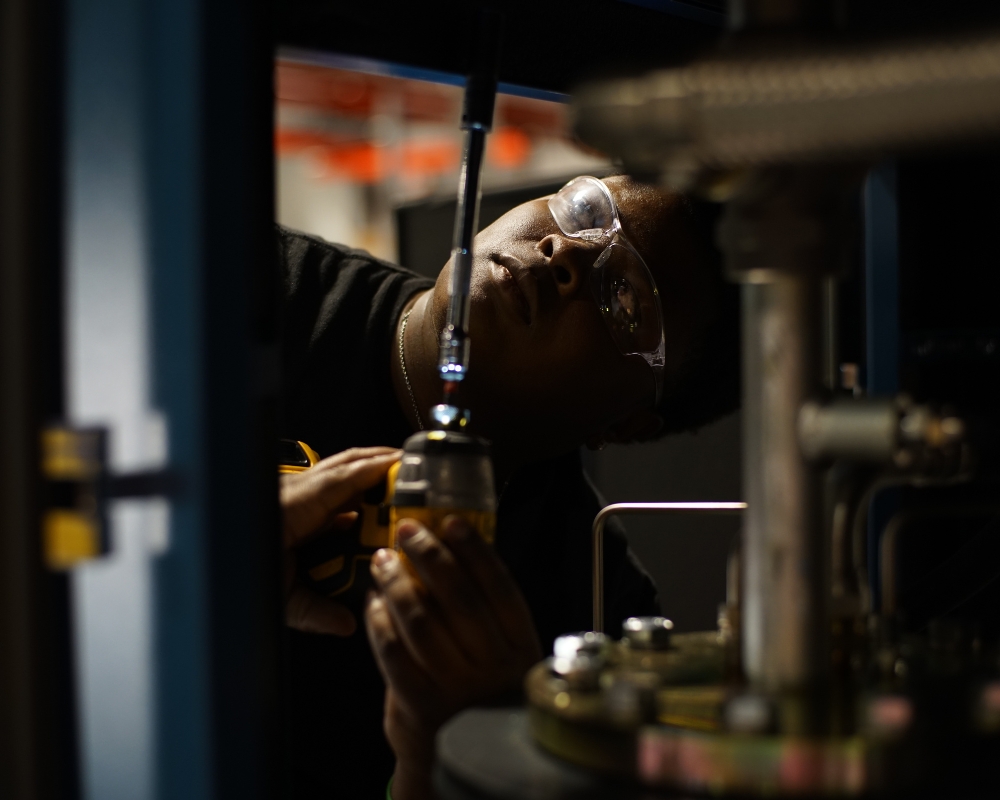
Deciding whether to repair or replace an air compressor is a critical decision for most facility managers.
Your compressor has been chugging away for years, faithfully supplying the needs of your compressed air system.
But then you start to notice some small issues:
- The pressure starts to be inconsistent.
- Air flow becomes difficult to control.
- Your compressor starts blowing fuses or throwing breakers.
- You have difficulty starting or stopping it.
- It’s making loud noises.
It happens to every compressor eventually—even ours (but not for decades).
You’re faced with a familiar dilemma: Does my compressor have more life in it? Or is it time to get a new one?
In most cases, your instinct is to repair. The desire to be conservative with resources (not to mention major pieces of equipment) is understandable. But in other cases, it may be most cost-effective to replace your ailing compressor.
Here’s a quick summary of your choices.
When to Repair
You’ll want to repair your rotary screw air compressor if your machine is under warranty, the fix is relatively simple, you’re experiencing a first-time failure, the equipment is relatively new, the parts are easy to get or the headaches in replacing the compressor scale up to migraines. Especially if you need to tear out walls, cut a hole in the roof or bring in a crane or helicopter.
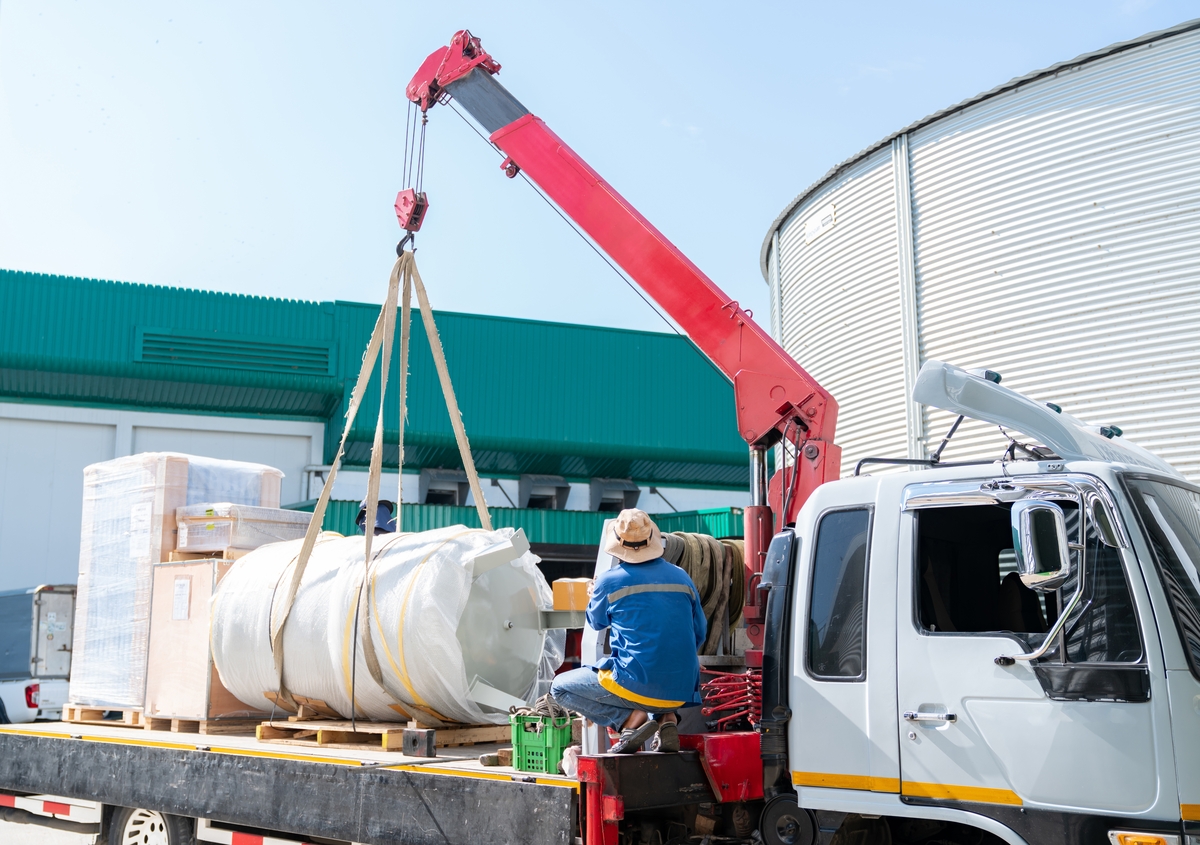
A key part of the repair vs. replace decision is the difficulty in removing the old equipment and bringing in the new one.
When to Replace
On the other hand, a few key issues drive the need for a replacement:
- Energy savings. Manufacturers are constantly working to improve the efficiency of their products, so the older your air compressor, the more energy savings you will get from a replacement. For many customers, energy savings alone almost always tip the scale in favor of a new unit. The older your air compressor, the more energy savings you will get from a replacement. Remember, electricity makes up 76% of a compressor’s total cost of ownership, according to the U.S. Department of Energy.
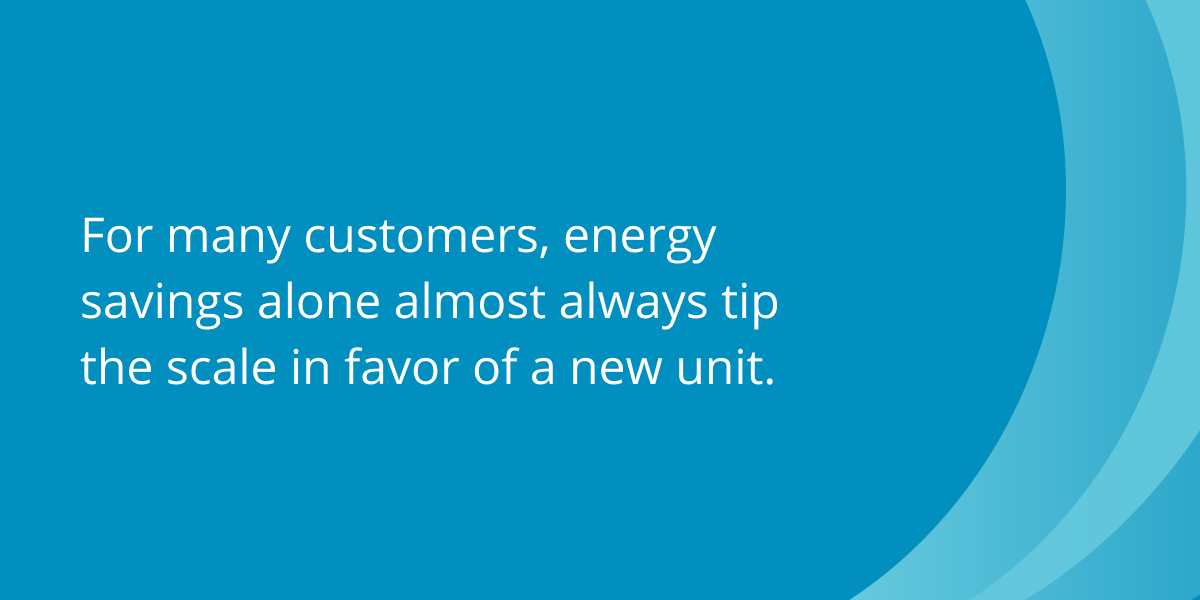
- Sizing problems. Everyone changes their equipment lineup, so if you’ve added new air tools, your equipment may be undersized. Unless you’re planning to downsize, you’ve probably outgrown your current compressor and need to scale up to a unit with higher capacity. You could also have the opposite problem: your compressor was sized with “room to grow” or purchased to handle end uses that have since been removed from the system. It may seem counterintuitive, but with air compressors, “too much” is almost as bad as “not enough,” wasting energy, reducing equipment lifetime and requiring more maintenance. For more on sizing, download our white paper, “Demystifying Air Compressor Sizing.”
- New technology. It’s essential to find out if new technology is available that would produce operational savings and shorten your payback period. An older compressor could well be a belt-drive model, requiring belt replacements. It may not have the high-efficiency motors of today’s compressors. It might not have been manufactured with the tight tolerances we achieve with today’s units. And it probably won’t have variable-speed drive technology, which has produced significant savings in some applications. (Find out about the pros and cons of VSDs in our blog post, “How Variable Speed Drive (VSD) Rotary Screw Air Compressors Save You Money.”)
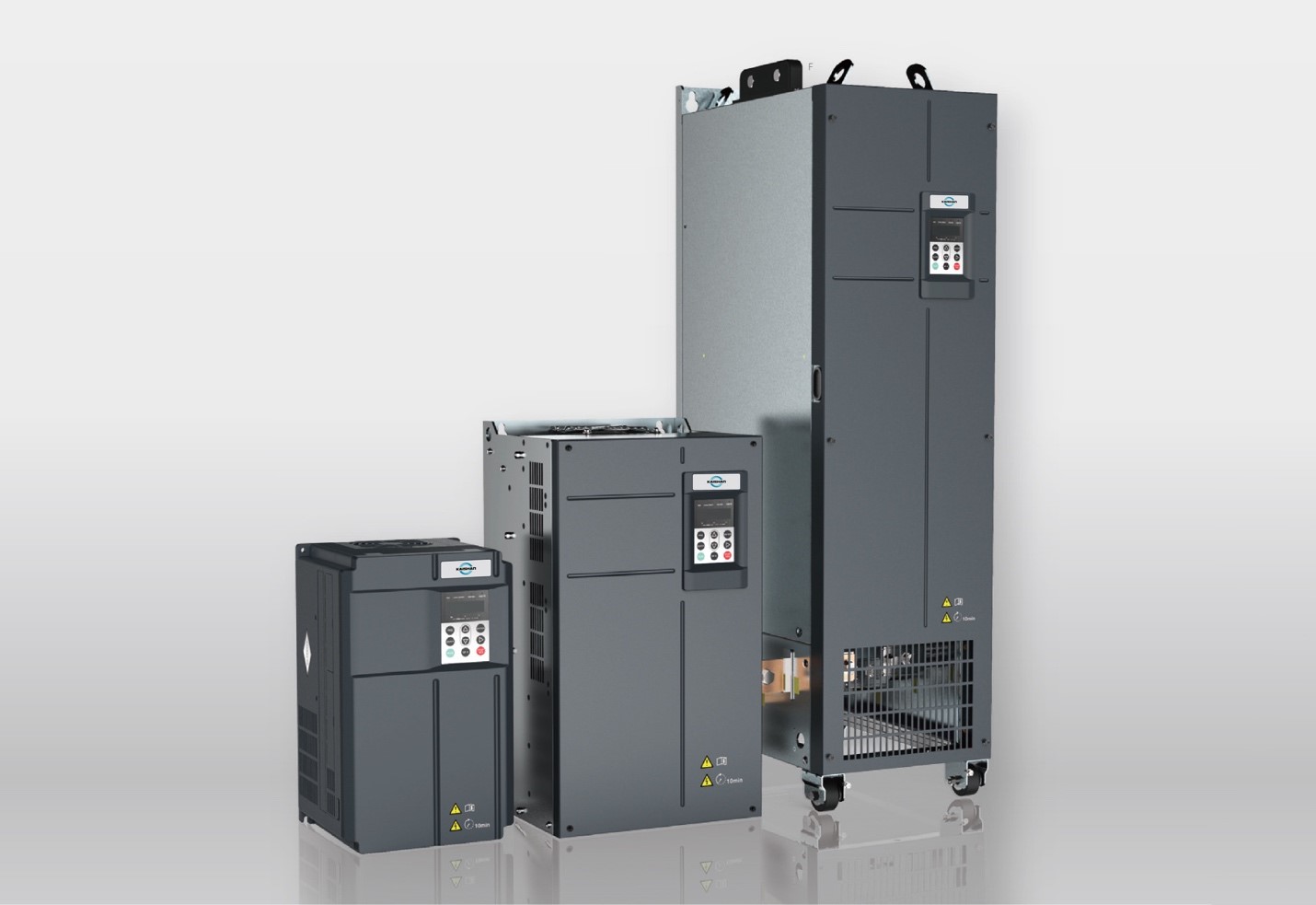
An older compressor probably won’t have variable-speed drive technology, which has produced significant savings in some applications.
- Financial considerations. Even if your existing compressor is functioning well, your finance department may decide that your company is in a good position to make a capital expenditure. A new purchase could allow you to depreciate the outlay, especially if you’ve already maxed out your deductions for your existing unit. And you may choose to avoid some of the costs of removal by keeping your old compressor in place as a backup, especially if it is still working well.
For more on the repair vs. replace decision, see our blog post, “Repairing Vs. Replacing an Air Compressor.”
Once you’ve decided to replace your compressor, you can focus on disposing of and recycling your old compressor.
When (and How) to Recycle
Recycling a rotary screw air compressor when it’s reached the end of its lifespan has many benefits, both for your company and the environment. It reduces the need to landfill old materials and avoids the cost (and energy use) associated with mining or obtaining new ones.
The following account is geared toward stationary units. There are additional options to recycle portables, especially the engines.
The first step in disposing of an air compressor is to check with local and state authorities to determine what regulations are in place.
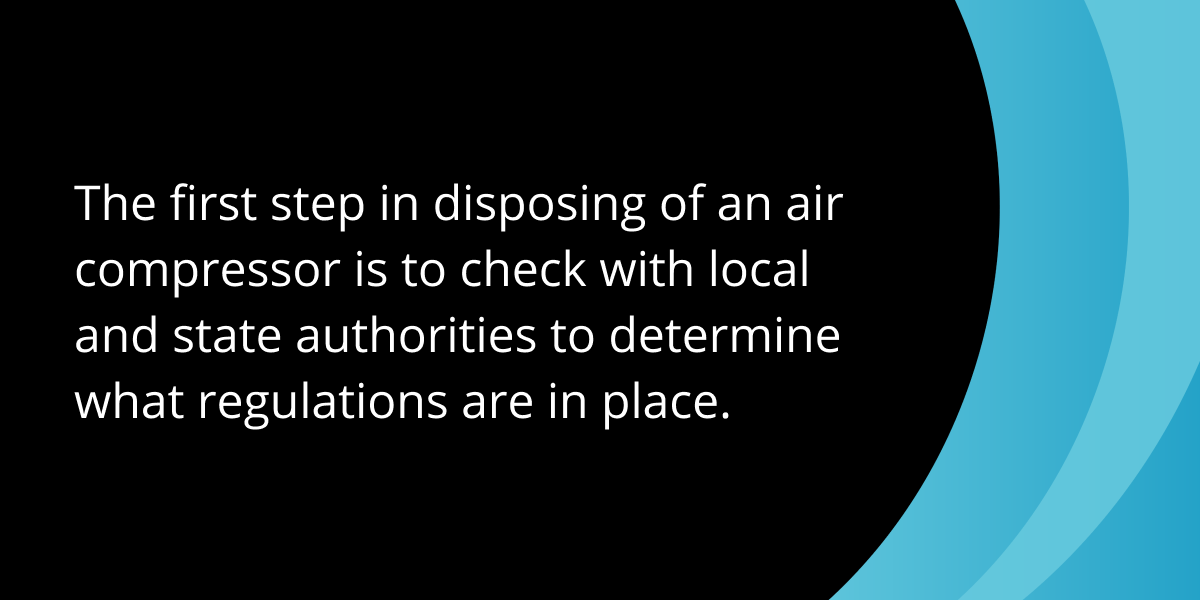
When you know the requirements, you need to resolve several air compressor disposal and recycling issues.
Liquids
Start the process by finding out what liquids and chemicals are inside your compressor and how to handle, store and dispose of them safely. Manufacturers of all kinds are required to make safety data sheets available. You can find ours on our safety data sheets (SDS) page.
The main liquids you need to consider include:
- Oil. Every rotary screw air compressor will have oil, and you must properly drain and discard that oil. Even oil-free units use oil to keep the high-speed rotating gears lubricated and to lower the operating temperatures in the stage-cooling jackets (keeping casting temperatures lower). However, oil does not enter the compression chamber in an oil-free machine as it does in an oil-lubricated rotary screw compressor.
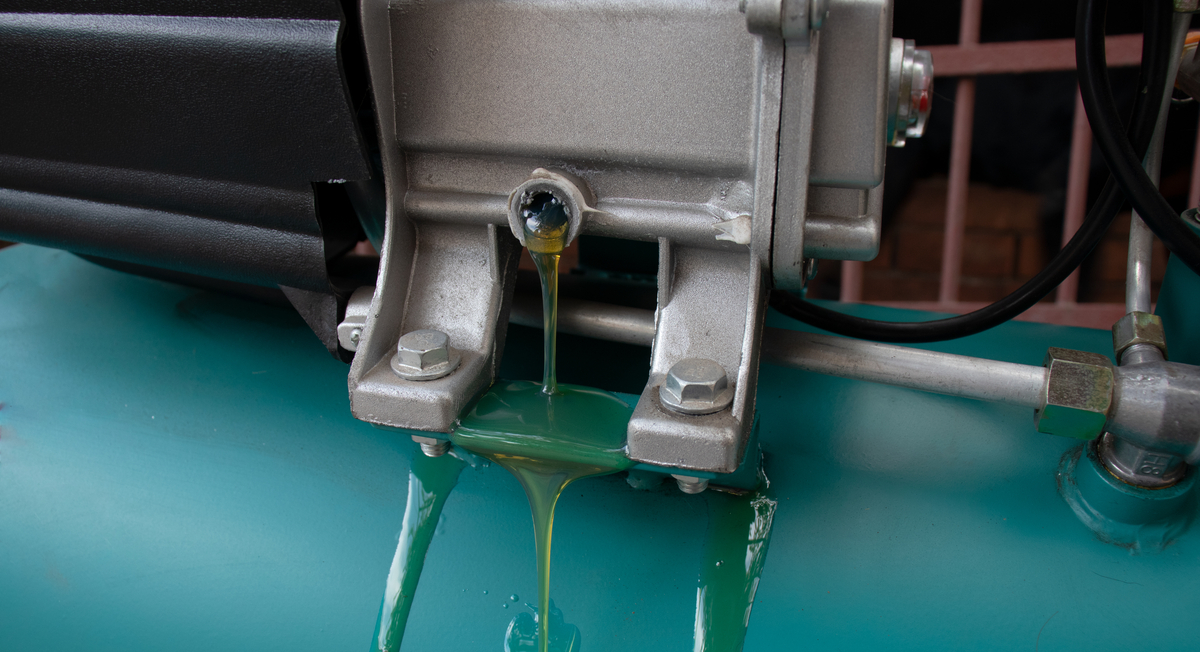
When you are disposing of an aging compressor, you should drain the oil and dispose of it properly.
- Condensate. The humidity in the incoming air condenses during the compression process and is removed from your compressor through drains and traps. Although it is mostly water, the resulting condensate can also contain oil and other contaminants, so most local municipalities require that you properly dispose of it. In other words, it cannot be dumped down the drain. This area is one where you must check applicable ordinances and regulations to determine what your local and state governments require.

After we've taken out the potentially hazardous liquids, we turn our attention to the controls.
Controls
The electronics in an older, legacy compressor may contain hazardous chemicals, such as lead, mercury, cadmium and arsenic. Twenty-five states require recycling of electronic equipment, according to the U.S. Environmental Protection Agency. You must take your controls to a recycling center for proper disposal in those states.
Next are the elements.
Elements
The majority of compressors have two elements, which are basically filters or separators: one in the air-oil separator (which contains oil) and one in your air filter, which contains oil, particulates and anything else in the air. Once again, they contain hazardous materials and should be disposed of properly.
After removing the elements, you are left with a pile of metal for recycling or disposal.
Metals
If you want to recycle the different types of metal in your compressor, the largest sources are the motor, the coolers and the structure or base. The metals you are most likely to find include:
- Aluminum in the core
- Iron in pumps
- Copper windings from the main motor and any auxiliary motors
- Nickel
- Stainless steel (especially if it’s water-cooled) and on all Kaishan control lines and fittings
What remains then is carbon steel in the motor and the airend that you could sell for scrap.
Throughout the process, your local air compressor expert can be a big help in making the right decisions.
Local Help in Your Repair/Replace/Recycle Decision-Making
Your local compressed air professional deals with these lifecycle issues almost daily. They can help you determine whether repair or replacement is most cost-effective. And, if you need to dispose of one, they know the relevant local and state requirements for air compressor recycling.

Your local compressed air professional can be a huge help in navigating the requirements for proper air compressor disposal.
Kaishan USA partners with a nationwide network of independent distributors to provide on-site help and consultation as needed, offering expert guidance, faster response times and personalized support tailored to your needs.
There’s no better way to get the help you need to make these challenging end-of-life decisions. Our distributors are factory-trained air compression experts who can service your air compressor system without a problem. And they have staff members who are skilled in advanced technology.
We work with independent, local distributors because it's the best way to serve you. With factory-trained technicians and a deep understanding of industrial applications, they help maximize efficiency and minimize downtime. So, when you buy through Kaishan, you're getting more than a product—you're getting a local partner who cares about your business and seeing it succeed.
Key Takeaways
- Repair your compressor if the fix is relatively simple, you’re experiencing a first-time failure, the equipment is relatively new, the parts are easy to get or there will be logistical challenges in removing it.
- Replace your compressor if it has failed several times, it’s more than a decade old or out of warranty, it does not meet current energy efficiency regulations, replacement parts are hard to get, or it’s not sized correctly.
- Recycle a compressor when it’s reached the end of its lifespan, reducing the need to landfill old materials and avoiding the cost (and energy use) associated with developing new materials.
- The first step in disposing of an air compressor is to check with local and state authorities to determine what regulations require.
- The main tasks for air compressor recycling include the safe removal and disposal of liquids, controls, elements and metals.
Let Us Help
Making the difficult repair/replace/recycle decisions about your rotary screw air compressor can be critical to the operation of your compressed air system and all the processes that rely on that system. If you need help, get in touch with the experts at Kaishan. Contact us today.
Listen to the Podcast Version
When to Repair and When to Replace
Alright, welcome back to The Big Dog Podcast! I’m Jason Reed, here with Lisa Saunders. Today’s episode—Repair or Replace?—is for every facility manager who’s ever stared down a cranky compressor and thought, “Now what?”Hey everyone! This is one of those questions that comes up way more often than people think. You’ve got a rotary screw compressor that’s been running for years, and suddenly it’s making weird noises, or the pressure’s all over the place. So, do you fix it, or is it time to say goodbye?
Yeah, and look, most folks wanna repair first. It’s just how we’re wired—nobody wants to toss out a big piece of equipment if you can squeeze a few more years out of it. But sometimes, you’re just throwing good money after bad.
Exactly. There are some clear signs that repair makes sense. Like, if your compressor’s still under warranty, or it’s a first-time failure, or honestly, if it’s just a simple fix. And don’t forget the logistics—sometimes replacing a compressor means tearing out walls or, I don’t know, bringing in a crane. That’s a headache nobody wants.
Yeah, I’ve seen places where swapping out a unit meant shutting down half the plant. If parts are easy to get and the machine’s not ancient, repair’s usually the move. But—big but here—if you’re dealing with the same breakdowns over and over, or the thing’s more than a decade old, you gotta start thinking replacement.
And don’t forget efficiency. The older your compressor, the more you’re probably paying in energy. I mean, electricity is, what, like 76% of the total cost of ownership for a compressor? That’s huge. If your unit’s not meeting current standards, or it’s just not sized right for your needs anymore, replacement can actually save you money in the long run.
Yeah, and sometimes the finance folks are actually on your side for once. If you can depreciate a new unit or keep the old one as backup, it’s worth a look. But, Lisa, you had a story about this from your first plant job, right?
Oh, yeah. So, my first year on the job, we had this ten-year-old compressor that started acting up—pressure drops, weird noises, the works. Everyone wanted to patch it up, but the thing was out of warranty, and parts were getting hard to find. We debated for days, but finally decided to replace it. Honestly, it saved us weeks of downtime. If we’d kept repairing, we’d have been chasing problems all year. Sometimes you just have to make the tough call.
That’s the thing—sometimes you gotta rip off the Band-Aid. Alright, let’s talk about why sizing and new tech matter so much when you’re thinking about upgrading.
Sizing, Energy Efficiency, and the Case for Upgrading
So, here’s the deal with sizing. If your compressor’s too small, it’s running nonstop, wearing itself out, and you’re still not getting enough air. Too big, and you’re wasting energy, paying for capacity you don’t need, and probably dealing with more maintenance than you should. It’s like—well, I was gonna say it’s like wearing shoes that don’t fit, but that’s a terrible analogy. You get what I mean.No, I think that works! And it’s not just about the size, it’s about how your needs have changed. Maybe you’ve added new tools, or taken some away. If your compressor was sized for a different setup, you’re either starving your system or bleeding money. And with new tech out there—like variable-speed drives and high-efficiency motors—you can get way more out of your system for less energy.
Yeah, variable-speed drives are a game changer. I mean, older belt-drive models just can’t compete. I worked with a Midwest manufacturer last year—well, I say “worked with,” but really I just got called in to look at their bills. They swapped out a fifteen-year-old unit for a new VSD model, and their energy costs dropped, like, overnight. Not saying that happens every time, but the payback period can be way shorter than people think.
And it’s not just about the money, either. Newer compressors are built with tighter tolerances, better controls, and they’re just more reliable. Less downtime, fewer headaches. Plus, if you’re thinking about sustainability, using less energy is always a win.
Right, and if you’re still on the fence, talk to your local air compressor expert. They see this stuff every day and can help you figure out if an upgrade makes sense for your setup. But let’s say you do decide to replace—what do you do with the old unit? That’s a whole other can of worms.
Responsible Disposal and Expert Guidance
Yeah, so, once you’ve made the call to replace, you can’t just haul the old compressor to the dumpster. There’s a right way to do it, and it starts with checking your local and state regulations. Some places are really strict about how you handle oil, condensate, electronics, and all those metals inside.Yeah, you gotta drain the oil—every compressor’s got it, even so-called “oil-free” ones use oil somewhere. And that condensate? It’s not just water, it can have oil and other junk in it, so you can’t just dump it down the drain. Gotta follow the rules, or you’re asking for trouble.
And don’t forget the electronics. Older controls can have stuff like lead or mercury, and in a lot of states, you’re required to recycle them. Same goes for the filters and separators—they can have hazardous materials, so they need to be handled properly.
Once you’ve stripped out the liquids and electronics, you’re left with a pile of metal—aluminum, iron, copper, nickel, stainless steel. Most of that can be recycled, which is way better than sending it to a landfill. Plus, you might even get a little money back for the scrap.
And honestly, recycling isn’t just good for the environment, it can save you on disposal costs, too. I remember a distributor we worked with—he helped a client recycle their old compressor, and not only did they avoid landfill fees, but they actually got a rebate from the recycler. Total win-win.
If you’re not sure where to start, reach out to your local Kaishan distributor. They know the ins and outs of the regulations, and they can walk you through the whole process—repair, replace, recycle, whatever you need. No shame in asking for help.
Absolutely. These decisions can get complicated, but you don’t have to go it alone. That’s what the experts are for. And hey, if you’re listening and you’ve got a story about a tough repair-or-replace call, we’d love to hear it—send it our way!
Alright, that’s gonna do it for this episode of The Big Dog Podcast. Next time, we’ll dig into some of the latest trends in compressed air tech—so stay tuned. Lisa, always a pleasure.
Thanks, Jason. And thanks to everyone for listening. Take care, and we’ll catch you next time.
See ya, folks.
Random stat or
customer quote
textXXtext
text

